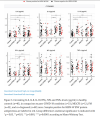Dolphin
Senior Member (Voting Rights)
Brain, Behavior, & Immunity - Health
Available online 4 July 2025, 101058In Press, Journal Pre-proof
Blood parameters differentiate post COVID-19 condition from Myalgic Encephalomyelitis/Chronic Fatigue Syndrome and Fibromyalgia
Karen Giménez -Orenga 1, Justine Pierquin 2, Joanna Brunel 2, Benjamin Charvet 2, Eva Martín-Martínez 3, Margot Lemarinier 4, Steven Fried 4, Alexandre Lucas 4, Hervé Perron 2 5, Elisa Oltra 6
1Doctoral School. Catholic University of Valencia San Vicente Mártir
2Geneuro-Innovation, Bioparc Laënnec, Lyon, France
3National Health Service, Manises Hospital, Valencia, Spain
4Institut des Maladies Métaboliques et Cardiovasculaires, INSERM, University Toulouse III–Paul Sabatier, UMR 1297-I2MC, Toulouse, France
5GeNeuro, Geneva, Switzerland
6Department of Pathology, School of Medicine and Health Sciences, Catholic University of Valencia, C/ Quevedo 2, 46001 Valencia, Spain
Received 10 February 2025, Revised 13 June 2025, Accepted 3 July 2025, Available online 4 July 2025.
https://doi.org/10.1016/j.bbih.2025.101058
ABSTRACT
Post-COVID-19 condition, such as Myalgic Encephalomyelitis/Chronic Fatigue Syndrome (ME/CFS) and Fibromyalgia (FM), are characterized by fatigue, pain, shortness of breath, sleep disturbances, cognitive dysfunction and other symptoms, heavily impacting on patients daily functioning.Moreover, over half of patients end up fulfilling ME/CFS and/or FM clinical criteria after a few months of SARS-CoV-2 infection.
Expression of the toxic human endogenous retrovirus (HERV)-W ENV protein can be induced by viral infection and HERV-W detection was correlated with acute COVID-19 severity and found significantly expressed in post-COVID-19 condition.
This study shows that HERV-W ENV may also be present in prepandemic cases of ME/CFS, FM or co-diagnosed with both clinical criteria, suggesting viral participation in these chronic diseases.
To learn whether associated antiviral mechanisms may also show differing patterns of immunological responses, we measured IgM, IgG, IgA and IgE antibody isotypes against SARS-CoV-2 spike and nucleocapsid antigens, the levels of IL-6, IL-8, IL-10, IFNγ and TNFα cytokines, the level of NfL, a neural damage biomarker, as well as some blood cell markers potentially related with fatigue.
Importantly, some of the measured variables showed a capacity to discriminate post-COVID-19 condition cases from all other participants, with 100% sensitivity and up to 71.9% specificity providing a new tool for a differential diagnosis between diseases or syndromes with so many overlapping clinical symptoms.
Interestingly, the detected markers showed moderate-to-strong correlations with patient symptoms pointing at novel therapeutic opportunities.
KEYWORDS
HERV-W-ENVpost COVID-19 condition
long COVID-19
SARS-CoV-2
Serology
Immunoglobulins
Cytokines
Myalgic Encephalomyelitis/Chronic Fatigue Syndrome
Fibromyalgia

